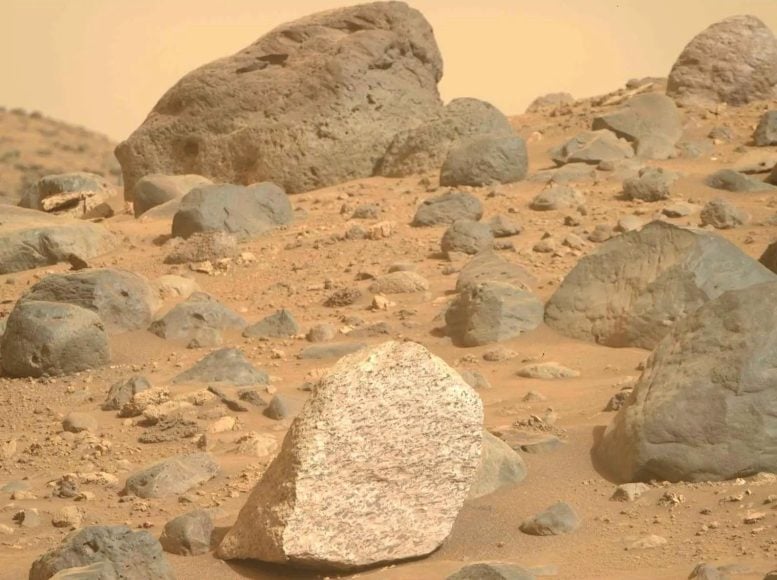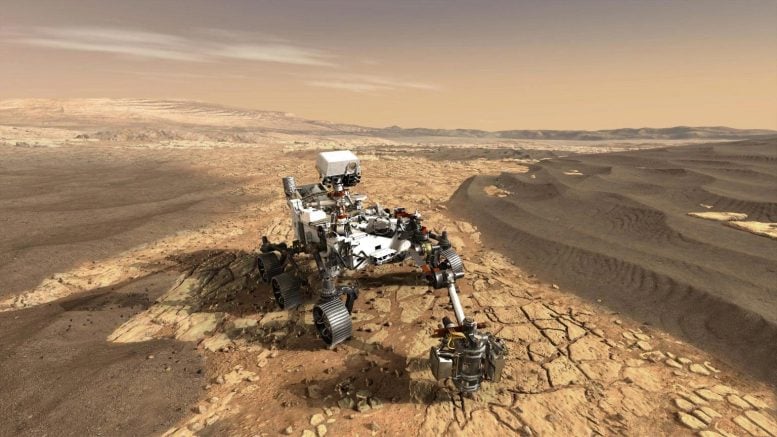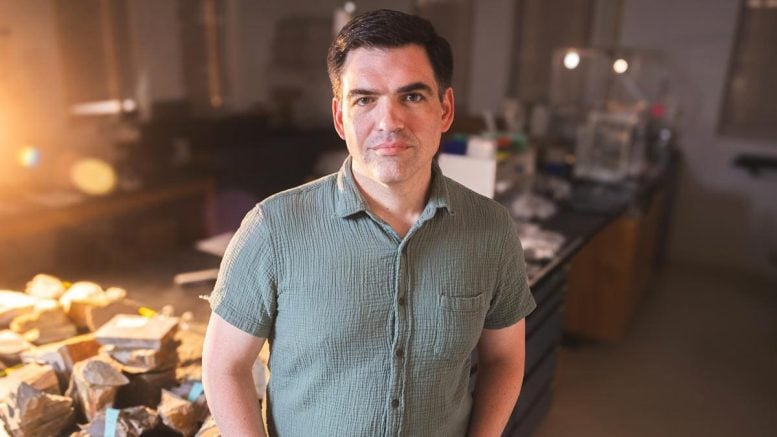
NASA’s Perseverance rover has uncovered strange chemical and mineral patterns in Jezero Crater’s Bright Angel formation that may be the strongest hints yet of ancient Martian life.
The rocks contain organic carbon, iron, sulfur, and phosphorus arranged in ways eerily similar to microbial processes on Earth.
Possible Martian Biosignatures in Jezero Crater
A recent study led in part by Texas A&M University geologist Dr. Michael Tice points to chemical clues in Martian rocks that may signal traces of ancient microbial life. The evidence comes from samples analyzed by NASA’s Perseverance rover.
An international group of researchers reported their results after examining a section of Jezero Crater called the Bright Angel formation. The name was inspired by places in Grand Canyon National Park and refers to the pale color of the rocks in that region. Bright Angel lies within the Neretva Vallis channel and contains mudstones packed with oxidized iron (rust), phosphorus, sulfur, and most importantly, organic carbon. While organic carbon has been detected on Mars before, often from sources like meteorites, this particular mix of elements could have provided an energy supply for primitive organisms.

Strikingly Different Rocks in Bright Angel Formation
“When the rover entered Bright Angel and started measuring the compositions of the local rocks, the team was immediately struck by how different they were from what we had seen before,” said Tice, a geobiologist and astrobiologist in the Department of Geology and Geophysics. “They showed evidence of chemical cycling that organisms on Earth can take advantage of to produce energy. And when we looked even closer, we saw things that are easy to explain with early Martian life but very difficult to explain with only geological processes.”
Tice went on to explain that “living things do chemistry that generally occurs in nature anyway given enough time and the right circumstances. To the best of our current knowledge, some of the chemistry that shaped these rocks required either high temperatures or life, and we do not see evidence of high temperatures here. However, these findings require experiments and ultimately laboratory study of the sample here on Earth in order to completely rule out explanations without life.”
The team published its findings in Nature.

Ancient Water-Shaped Sediments
The Bright Angel formation is composed of sedimentary rocks deposited by water, including mudstones (fine-grained sedimentary rocks made of silt and clay) and layered beds that suggest a dynamic environment of flowing rivers and standing water. Using Perseverance’s suite of instruments, including the SHERLOC and PIXL spectrometers, scientists detected organic molecules and small arrangements of minerals that appear to have formed through “redox reactions,” chemical processes involving the transfer of electrons. On Earth, those processes are often driven by biological activity.
Among the most striking features are tiny nodules and “reaction fronts”— nicknamed “poppy seeds” and “leopard spots” by the rover team — enriched in ferrous iron phosphate (likely vivianite) and iron sulfide (likely greigite). These minerals commonly form in low-temperature, water-rich environments and are often associated with microbial metabolisms.
“It’s not just the minerals, it’s how they are arranged in these structures that suggests that they formed through the redox cycling of iron and sulfur,” Tice said. “On Earth, things like these sometimes form in sediments where microbes are eating organic matter and ‘breathing’ rust and sulfate. Their presence on Mars raises the question: could similar processes have occurred there?”
Organic Carbon in Apollo Temple
The SHERLOC instrument detected a Raman spectral feature known as the G-band, a signature of organic carbon, in several Bright Angel rocks. The strongest signals came from a site called “Apollo Temple,” where both vivianite and greigite were most abundant.
“This co-location of organic matter and redox-sensitive minerals is very compelling,” said Tice. “It suggests that organic molecules may have played a role in driving the chemical reactions that formed these minerals.”
Tice notes it’s important to understand that “organic” does not necessarily mean formed by living things.
“It just means having a lot of carbon-carbon bonds,” he explained. “There are other processes that can make those besides life. The kind of organic matter detected here could have been produced by abiotic processes or it could have been produced by living things. If produced by living things, it would have to have been degraded by chemical reactions, radiation or heat to produce the G-band that we observe now.”
Life or Geochemistry? Two Competing Scenarios
The study outlines two possible scenarios: one in which these reactions occurred abiotically (driven by geochemical processes) and another in which microbial life may have affected the reactions, as it does on Earth. Strikingly, although some features of the nodules and reaction fronts could be produced by abiotic reactions between organic matter and iron, the known geochemical processes that could have produced the features associated with sulfur usually only work at relatively high temperatures.
“All the ways we have of examining these rocks on the rover suggest that they were never heated in a way that could produce the leopard spots and poppy seeds,” said Tice. “If that’s the case, we have to seriously consider the possibility that they were made by creatures like bacteria living in the mud in a Martian lake more than three billion years ago.”
While the team emphasizes that the evidence is not definitive proof of past life, the findings meet NASA’s criteria for “potential biosignatures” — features that warrant further investigation to determine whether they are biological or abiotic in origin.
Rock Sample for Future Return to Earth
Perseverance collected a core sample from the Bright Angel formation, named “Sapphire Canyon,” which is now stored in a sealed tube carried by the rover. This sample is among those prioritized for return to Earth in a potential future mission.
“Bringing this sample back to Earth would allow us to analyze it with instruments far more sensitive than anything we can send to Mars,” said Tice. “We’ll be able to look at the isotopic composition of the organic matter, the fine-scale mineralogy, and even search for microfossils if they exist. We’d also be able to perform more tests to determine the highest temperatures experienced by these rocks, and whether high temperature geochemical processes might still be the best way to explain the potential biosignatures.”
Earth-Mars Parallels in Ancient Microbial Life
Tice, who has long studied ancient microbial ecosystems on Earth, said the parallels between Martian and terrestrial processes are striking — with one important difference.
“What’s fascinating is how life may have been making use of some of the same processes on Earth and Mars at around the same time,” he said. “We see evidence of microorganisms reacting iron and sulfur with organic matter in the same way in rocks of the same age on Earth, but we’d never be able to see exactly the same features that we see on Mars in the old rocks here. Processing by plate tectonics has heated all our rocks too much to preserve them this way. It’s a special and spectacular thing to be able to see them like this on another planet.”
Explore Further:
- NASA Perseverance Rover’s Stunning Find May Be Mars’ First Sign of Life
- Strange Mars Mudstones May Hold the Strongest Clues Yet of Ancient Life
Reference: “Redox-driven mineral and organic associations in Jezero Crater, Mars” by Joel A. Hurowitz, M. M. Tice, A. C. Allwood, M. L. Cable, K. P. Hand, A. E. Murphy, K. Uckert, J. F. Bell III, T. Bosak, A. P. Broz, E. Clavé, A. Cousin, S. Davidoff, E. Dehouck, K. A. Farley, S. Gupta, S.-E. Hamran, K. Hickman-Lewis, J. R. Johnson, A. J. Jones, M. W. M. Jones, P. S. Jørgensen, L. C. Kah, H. Kalucha, T. V. Kizovski, D. A. Klevang, Y. Liu, F. M. McCubbin, E. L. Moreland, G. Paar, D. A. Paige, A. C. Pascuzzo, M. S. Rice, M. E. Schmidt, K. L. Siebach, S. Siljeström, J. I. Simon, K. M. Stack, A. Steele, N. J. Tosca, A. H. Treiman, S. J. VanBommel, L. A. Wade, B. P. Weiss, R. C. Wiens, K. H. Williford, R. Barnes, P. A. Barr, A. Bechtold, P. Beck, K. Benzerara, S. Bernard, O. Beyssac, R. Bhartia, A. J. Brown, G. Caravaca, E. L. Cardarelli, E. A. Cloutis, A. G. Fairén, D. T. Flannery, T. Fornaro, T. Fouchet, B. Garczynski, F. Goméz, E. M. Hausrath, C. M. Heirwegh, C. D. K. Herd, J. E. Huggett, J. L. Jørgensen, S. W. Lee, A. Y. Li, J. N. Maki, L. Mandon, N. Mangold, J. A. Manrique, J. Martínez-Frías, J. I. Núñez, L. P. O’Neil, B. J. Orenstein, N. Phelan, C. Quantin-Nataf, P. Russell, M. D. Schulte, E. Scheller, S. Sharma, D. L. Shuster, A. Srivastava, B. V. Wogsland and Z. U. Wolf, 10 September 2025, Nature.
DOI: 10.1038/s41586-025-09413-0
Never miss a breakthrough: Join the SciTechDaily newsletter.